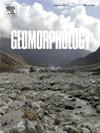超临界流中泥沙超载引起的沉降波速的实验室测定
IF 3.1
2区 地球科学
Q2 GEOGRAPHY, PHYSICAL
引用次数: 0
摘要
本文提出了一个基于实验的公式来估计泥沙超载的河道中堆积波的传播速度。从工程角度来看,速度参数很重要,因为河流形态的变化在很大程度上导致了水力灾害;管理后者可能需要可靠的预测,即沉积波从沉积物源区传播到一个关键地点需要多长时间。在本研究中,通过实验方法确定了沉积波速度,实现了泥沙超载的实验室运行,并对所得到的河床剖面进行了详细的时间测量。超临界流动条件被认为是最具代表性的高地环境。在这些条件下,沉积过程是分散的,需要特别注意量化波浪的代表性速度;利用文献对堆积过程的分析描述的协同作用,适当地平均了床高程的局部和瞬时传播速度,以估计运动的每个实验的总体速度值。给出了一个公式,可以在±25%的精度范围内预测该体速度的实验值;公式中唯一的控制参数是表示泥沙超载程度的荷载比。本文章由计算机程序翻译,如有差异,请以英文原文为准。
Laboratory determination of aggradation wave celerity due to sediment overloading in supercritical flow
The manuscript presents an experiment-based formula to estimate the celerity of propagation of an aggradation wave along a river channel overloaded with sediment. The celerity parameter is important from an engineering point of view, since changes in river morphology can largely contribute to hydraulic hazard; managing the latter may require a reliable prediction of how long it would take for an aggradation wave to propagate from sediment source areas to a critical spot. In the present study, the determination of the aggradation wave celerity was approached experimentally, realizing laboratory runs with sediment overloading and detailed temporal measurement of the resulting bed profiles. Supercritical flow conditions were considered, as most representative of upland environments. In these conditions the aggradation process is dispersive, requiring particular care in quantifying a representative celerity for the wave; exploiting a synergy with a literature analytical depiction of the aggradation process, the local and instantaneous celerity of propagation of the bed elevation was suitably averaged to estimate a bulk celerity value for each experiment of the campaign. A formula is provided allowing to predict the experimental values of this bulk celerity within ±25 % accuracy; the only control parameter in the formula is the load ratio that represents the degree of sediment overloading.
求助全文
通过发布文献求助,成功后即可免费获取论文全文。
去求助
来源期刊

Geomorphology
地学-地球科学综合
CiteScore
8.00
自引率
10.30%
发文量
309
审稿时长
3.4 months
期刊介绍:
Our journal''s scope includes geomorphic themes of: tectonics and regional structure; glacial processes and landforms; fluvial sequences, Quaternary environmental change and dating; fluvial processes and landforms; mass movement, slopes and periglacial processes; hillslopes and soil erosion; weathering, karst and soils; aeolian processes and landforms, coastal dunes and arid environments; coastal and marine processes, estuaries and lakes; modelling, theoretical and quantitative geomorphology; DEM, GIS and remote sensing methods and applications; hazards, applied and planetary geomorphology; and volcanics.
 求助内容:
求助内容: 应助结果提醒方式:
应助结果提醒方式:


